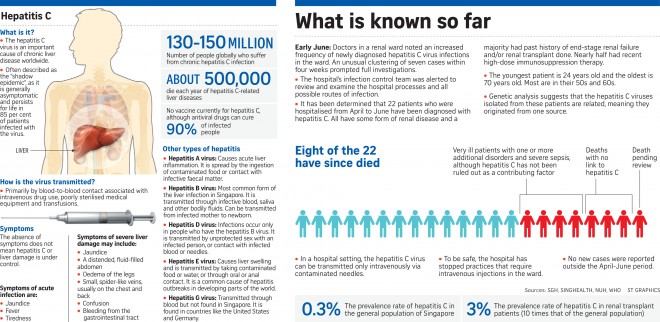Hepatitis C outbreak: Mystery of virus spread confounds medical experts

Professor Fong Kok Yong, chairman of SGH’s medical board, giving a media briefing yesterday, together with (from left) Professor Ang Chong Lye, SGH’s chief executive officer, and Dr Tracy Ayre, SGH’s chief nurse. Prof Fong said the chance of the hepatitis C virus being spread through contaminated blood was “very minuscule”. ST PHOTO: AZIZ HUSSIN
SINGAPORE – It is a virus that does not spread easily – and dies quickly.
That is why experts are still racking their brains over the source of the hepatitis C virus that infected at least 21 kidney patients at Singapore General Hospital (SGH).
The hepatitis C virus is generally transmitted by blood or blood products. It is not airborne and cannot be spread through social contact, sharing of utensils or drinking from the same glass, or through food or water.
Professor Fong Kok Yong, chairman of SGH’s medical board, said the virus is “very fragile and dies quickly” when exposed.
He added that the chance of the virus being spread through contaminated blood was “very minuscule.”
Article continues after this advertisementNot only does the blood bank take great care, but also, not all the infected patients had a blood transfusion.
Furthermore, they were from different blood groups, and would not be receiving blood from the same donor.
The hospital had at first suspected that the virus was spread through a dialysis machine, which kidney failure patients use to clean their blood of toxins.
But by the end of May, investigations had shown that this was not the source of transmission as the patients had used different machines, and other patients using those machines were not infected.
The hospital then turned to the use of multi-dose vials, possibly those containing insulin, which some diabetic patients need.
These vials contain more than one dose and are often shared between two and three patients.
SGH’s chief nurse, Dr. Tracy Ayre, said the protocol is for the user, either a doctor or a nurse, to swab the rubber top of the vial before injecting a new needle into the vial to extract the required amount of liquid.
She said: “You use a new needle, new syringe for every patient, for every episode.”
With one vial shared by about three patients, in order to infect more than 20 patients, a fairly large number of vials would need to be contaminated.
When posed this question, Professor Ang Chong Lye, SGH’s chief executive officer, replied: “That’s why we couldn’t confirm that it is from multi-dosing. We took that extra precaution to stop multi- dosing.
“But we cannot pinpoint for sure that that is the ultimate cause.”
Asked if it had ruled out foul play, SGH said: “Since investigations are ongoing, we cannot rule out any possibility.”
Hopefully, the new review committee set up by the Health Ministry can shed more light.
RELATED STORIES
Hepatitis C no longer a ‘death sentence’
Enrico Labayen, 62, is healing himself by dancing more slowly
